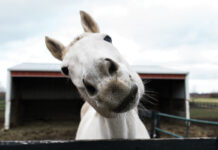
Soil is made up of organic matter, air, water and minerals. It provides nutrients for plants, which are the cornerstone of your horse’s diet. For desirable grazing to thrive, the soil must have the proper pH level. “pH” is a measurement of how alkaline or acidic a substance is; this level will greatly affect a plant’s ability to draw nutrients from the soil.
“While many [people] can read the report, getting some help in the interpretation and subsequent fertilizer needs is something that horse owners can get from a local extension agent,” says Coleman. Using the test results helps the farm owner make good decisions on how much fertilizer to apply so that the plant growth is what you’re trying to get and you are not spending money that isn’t needed.”
Adjusting your soil’s pH traditionally involves adding lime if your fields are acidic or some other conditioner (possibly one including sulfur) if the soil is alkaline.
How Do I Test My Soil?
Horse owners have some options for soil testing. They can take the soil sample themselves; all farm owners need to do is contact their local county extension office to pick up a soil probe and directions for taking the sample. (You can find a map to help locate your office here.) This typically involves discarding the organic matter on top of the soil, using the coring tool to get a samples that is about 3 inches deep and placing the sample in a sampling bucket. Mix all the samples from one field together before sending them in for analysis.
If you aren’t interested in taking your own sample, there are companies available that will do it for you. These can include local farm and feed stores, seed stores and more. You will need to contact them directly to see if they can assist you.
When and Where Should You Collect Soil Samples for Testing?
While soil testing can be done at any time, it’s best to do it in the fall or early spring. This gives you time to adjust the soil before you before you seed it or before plants grow in as it may take a few months for the corrections to take effect.
Soil testing should be done on all fields, and in multiple locations in each field as fields can vary greatly. “The samples should be taken from random sites across the field to make sure that variation is accounted for. Your county agent can give directions on how this should be done and how the samples should be taken and handled for submission to the lab for testing,” says Coleman.
You should test your soil “at least every other year, but that can depend on the plant growth and how much of the soil nutrients are being removed each year,” he says. Here again, county extension agents can give advice related to the area being sampled.

Hay Tests for Horse Owners
Horse owners are also encouraged to test the hay that comes off of farm fields, but what does this test actually explain? A hay test “gives the nutrient profile of the feed,” says Coleman. “The horse owner can see the moisture, fiber, crude protein and, depending on the analysis asked for, possibly the carbohydrate levels and minerals.”
Hay testing is done using a core probe that can be obtained from a local extension agent. “The farm owner will take 20 to 25 cores from each lot of hay being used. The cores are mixed and the sample sent to the lab for analysis,” says Coleman.
A hay test differs from a soil test in that the samples must be sent to a lab; there is no at-home analysis option. There are many labs available across the country that test hay. “Some hay suppliers provide a nutrient analysis of the hay they sell, but not always. If you buy 10 bales at a time, the analysis might not be really useful as the sample results come back about the time you finish the feeding the hay,” he notes.
If you’re an owner who is buying lots of hay from multiple sources, you may want to test every lot of hay, every year. Last year’s hay for the same field can be very different, so it should be sampled so you know exactly what you are feeding.
Sarah Coleman has a soft spot for chestnuts with chrome, including her off-the-track Thoroughbred Chisholm, whom she is training to be a hunter. Based in Lexington, Ky., she is the Director of Education and Development for New Vocations Racehorse Adoption Program.






